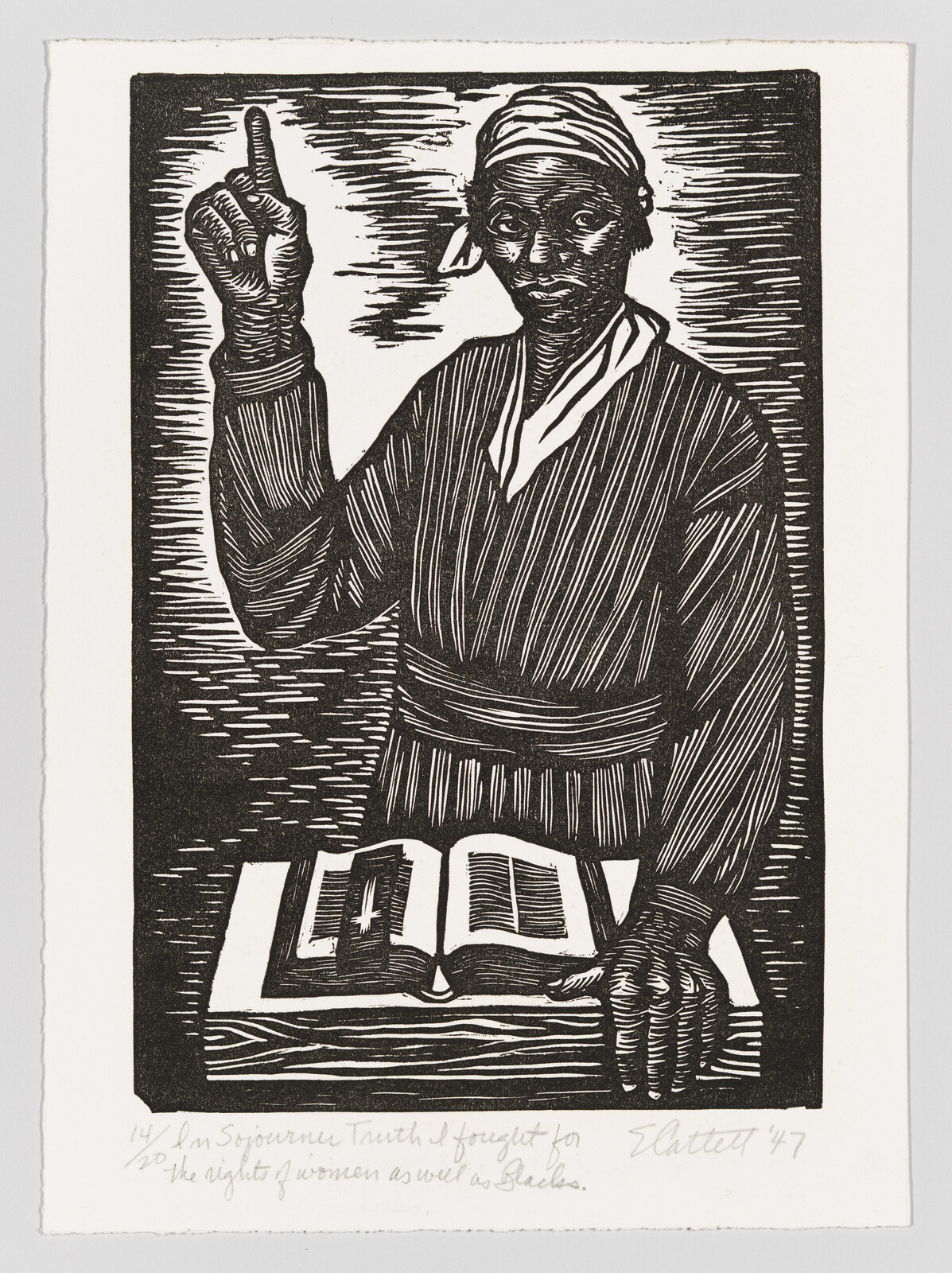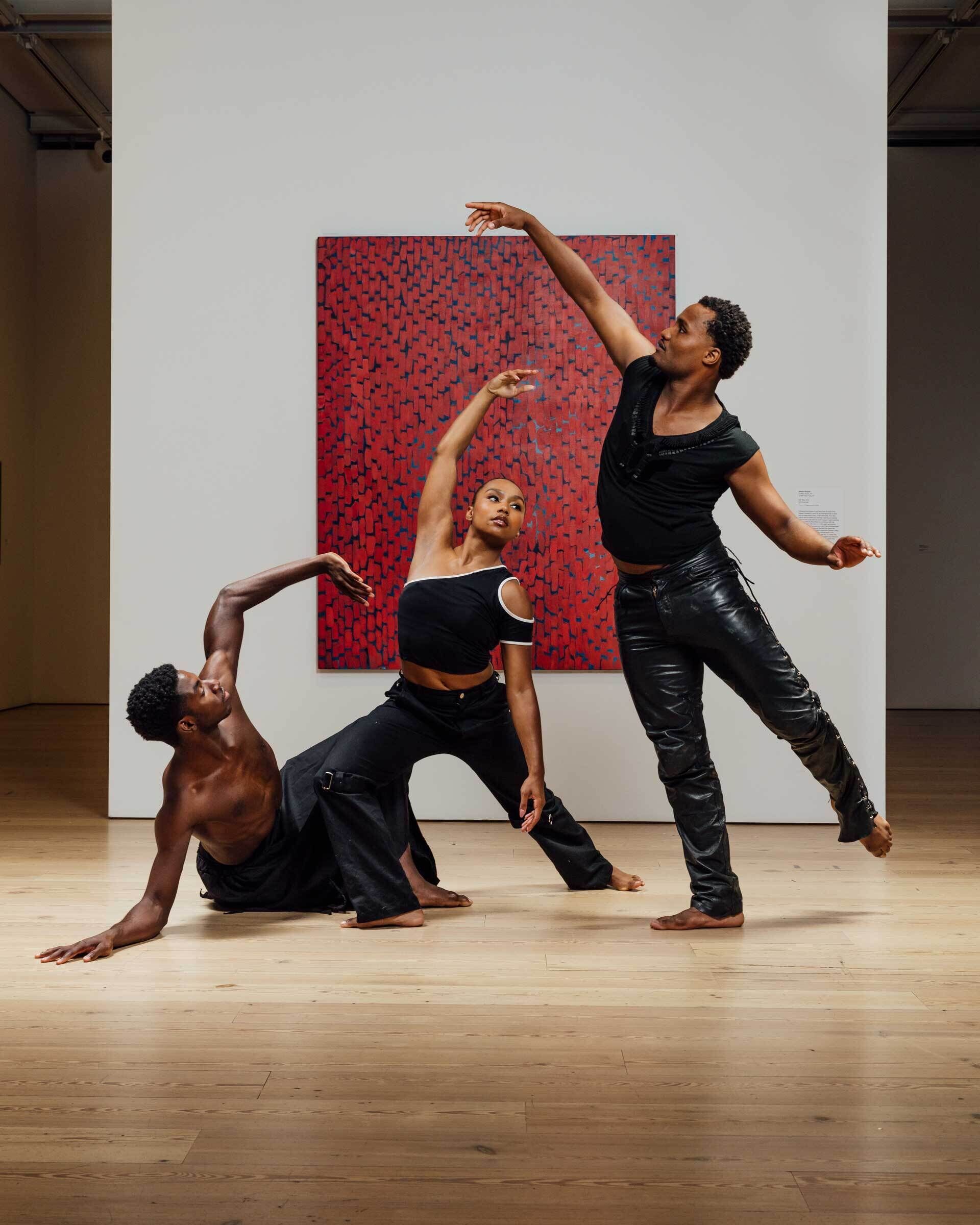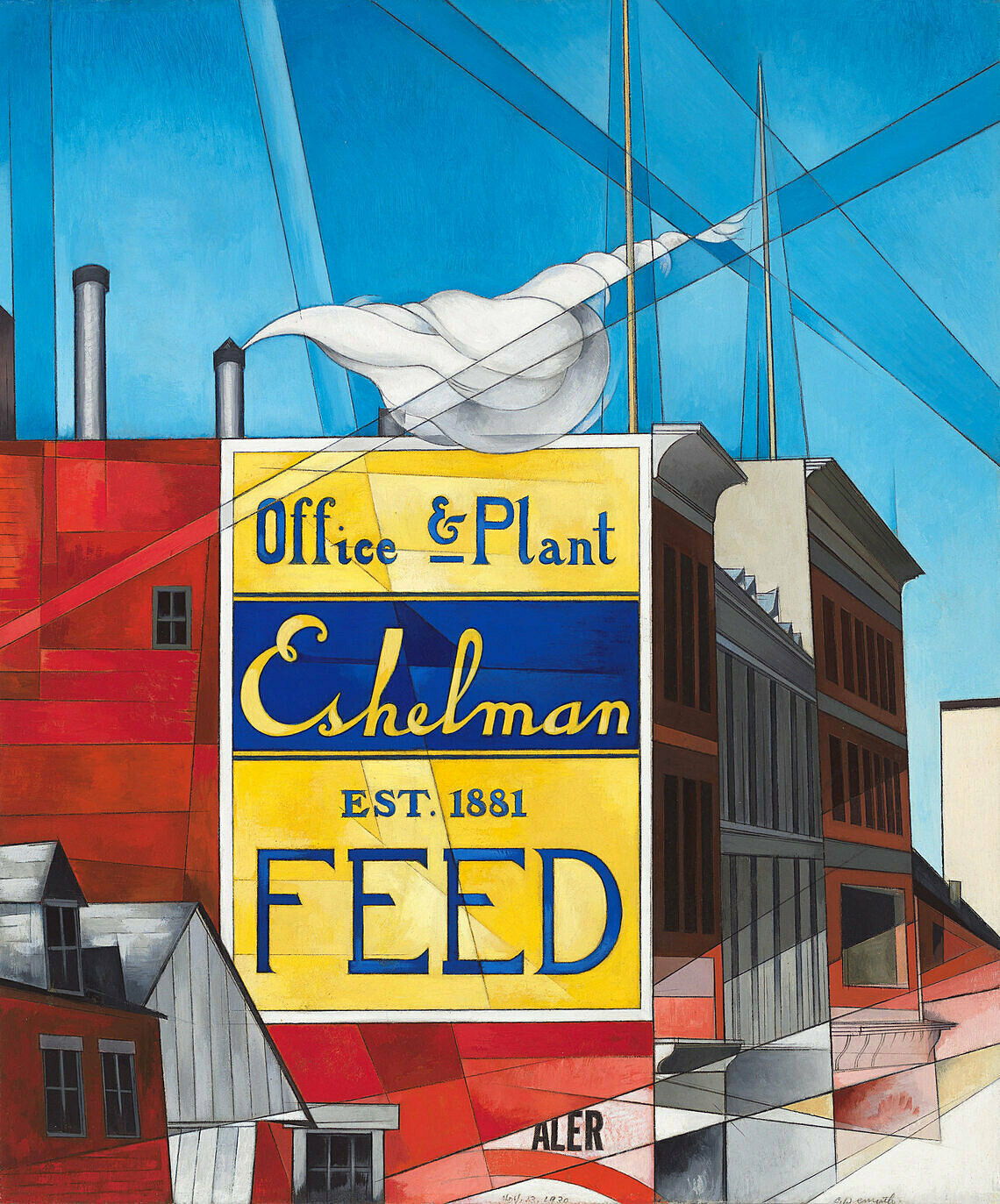Elizabeth Catlett
In Sojourner Truth I fought for the rights of women as well as Negroes
1947, printed 1989
Not on view
Date
1947, printed 1989
Classification
Prints
Medium
Linoleum cut
Dimensions
Sheet: 10 1/4 × 7 3/8 in. (26 × 18.7 cm)
Image: 8 7/8 × 5 15/16 in. (22.5 × 15.1 cm)
Accession number
95.195
Series
The Negro Woman, 1946-47 (re-titled The Black Woman, 1989)
Edition
14/20 | Second print run
Publication
Printed by Robert Blackburn Printmaking Workshop
Credit line
Purchase, with funds from the Print Committee
Rights and reproductions
© Catlett Mora Family Trust / Licensed by VAGA at Artists Rights Society (ARS), New York
Audio
-
0:00
Elizabeth Catlett, In Sojourner Truth I fought for the rights of women as well as Negroes, 1947, printed 1989
0:00
Narrator: This work by Elizabeth Catlett is a vertical linoleum cut print on paper depicting nineteenth century formerly enslaved African-American abolitionist and activist Sojourner Truth at the center. It is titled In Sojourner Truth I fought for the rights of women as well as Negroes. The sheet of paper is a little over 10 inches by 7 inches, while the image is set about an inch in.
Truth commands the frame with a resolute expression. She faces the viewer with her right hand raised, elbow bent, finger pointing upward to the sky, almost arriving at the edge of the composition. Her left palm is planted firmly down on a podium with her fingers holding the front edge. Her hands define a diagonal tension in the composition like the graphic figures found on playing cards. Wood grain runs across the sides of the podium under her fingers while the top is completely white. A Bible lies open with a bookmark resting flat on the page. A stark white cross decorates the surface of the black bookmark. Two dense columns of solid lines suggest text on each page. The edges of the print are filled with a solid black border. The background is composed of short dense horizontal lines which reveal the direction cut into the linoleum to make the print. As they run toward the center of the image to frame Truth’s body, the lines end, creating a halo of white negative space around Truth’s body, as if a light was illuminating her from behind.
Truth’s head is wrapped in white cloth with a tied edge poking out from behind her head, seen on the side of her face. She looks straight ahead with lips slightly pursed. The horizontal lines that define Truth’s skin are closer together, swaying in more organic shapes which showcase the linoleum cut style. Gaps emerge at her forehead and cheeks suggesting light catching her bone structure. A white scarf winds around her neck to meet in a V-shape tucked into her dress. The dress is made of vertical lines that look like stripes or pleats that pass under a thick waistband. The vertical lines of her dress contrast strongly with the horizontal lines of the background, pulling Truth’s silhouette into the foreground. The title, artist signature, and date are written in graphite below the print along with the edition which is 14/20. This work is the sixth in a series of fifteen linoleum cuts made by Catlett to celebrate Black women’s labor. It is displayed in a row of four prints from this series.
-
Elizabeth Catlett, Prints
In Where We Are (Spanish)
0:00
Elizabeth Catlett, Prints
0:00
David Breslin: Elizabeth Catlett realizó esta serie de grabados llamada I Am the Negro Woman, en 1947, en su taller en la Ciudad de México.
Narrator: David Breslin es el Curador Familia DeMartini y Director de la colección.
David Breslin: Esta serie de obras son grabados sobre linóleo que muestran a personajes, como Harriet Tubman, Sojourner Truth y Phyllis Wheatley, y la idea de que su labor —ahora famosa labor de mujeres negras— debe ser celebrada, vista y convertida en un modelo a seguir. Como parte de esta serie también hay obras dedicadas a “mujeres desconocidas” y al trabajo invisible —bien fuera en el hogar, en los campos o en las fábricas—, una labor que pasaba inadvertida y que nadie consideraba heroica. La propuesta de Catlett era no sólo celebrar a figuras ejemplares como [Sojourner] Truth, sino celebrar también el trabajo diario de las desconocidas, de aquellas que realizan su trabajo sin recibir atención alguna.
-
0:00
Elizabeth Catlett, Prints
0:00
David Breslin: Elizabeth Catlett made this body of prints, I Am the Negro Woman, in 1947 at a workshop in Mexico City.
Narrator: David Breslin is the DeMartini Family Curator and Director of the collection.
David Breslin: This group of works are linoleum woodcuts that feature some known figures like Harriet Tubman, Sojourner Truth, and Phyllis Wheatley, and the idea that their labor—now-famous black women’s labor—should be celebrated, seen, and be made as a model. But also within this group of works are “unknown women” and the invisible labor. Whether it’s in the home, or in the field, or in the factory, that frequently wasn’t seen or wasn’t made heroic. For Catlett, the idea was not only to celebrate these exemplary figures like [Sojourner] Truth, but also to celebrate the everyday labor of ones who have not been noticed—who go unnoticed throughout their work.
Exhibitions
Installation photography
-
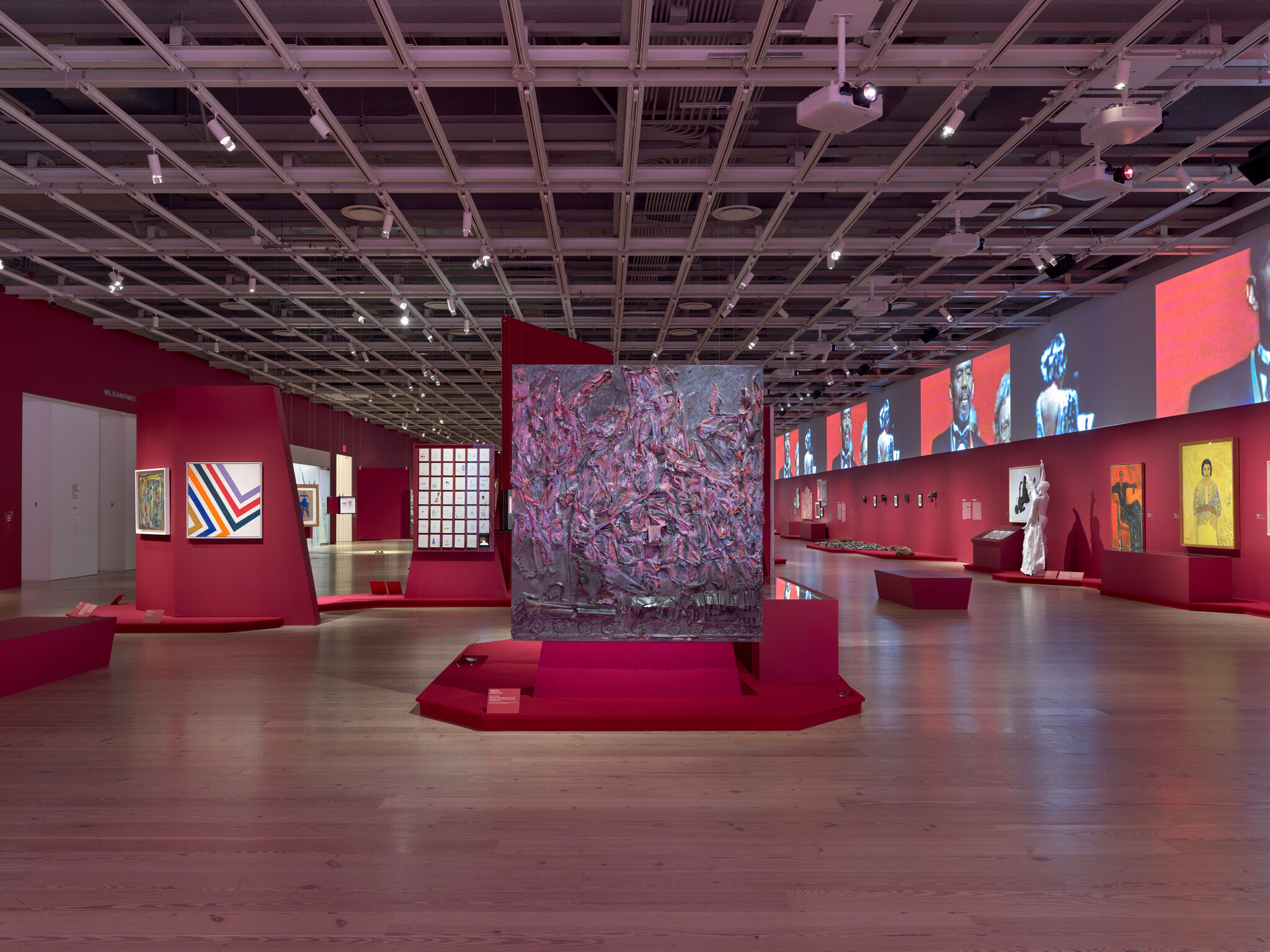

Installation view of Edges of Ailey (Whitney Museum of American Art, New York, September 25, 2024-February 9, 2025). From left to right: Norman Lewis, Phantasy II, 1946; Sam Gilliam, Swing 64, 1964; Bill Traylor, Untitled (Man in a Blue House), date unknown; Ralph Lemon, Bongos and Djembe, 1999; Ralph Lemon, Untitled (On Black music), 2001-07; Thornton Dial, Soul Train, 2004; Sam Doyle, Frank Capers, 2023; Sam Doyle, LeBe, 1970s; Wadsworth Jarrell, Together We Will Win, 1973; Faith Ringgold, United States of Attica, 1971; Wadsworth Jarrell, Revolutionary (Angela Davis), 1972; James Van Der Zee, Marcus Garvey Rally, 1924; Jeff Donaldson, Soweto/So We Too, 1979; Maren Hassinger, River, 1972/2012; Maren Hassinger, River, 1972/2012; Melvin Edwards, Utonga (Lynch Fragment), 1988; Aaron Douglas, Bravado, 1926; Melvin Edwards, Chitungwiza from the Lynch Fragment series, 1989; Aaron Douglas, Flight, 1926; Melvin Edwards, Katura from the Lynch Fragment series, 1986; Aaron Douglas, Surrender, 1970; Melvin Edwards, Cup of? From the Lynch Fragment series, 1988; In vitrine, from left to right: Elizabeth Catlett, I am the Negro Woman, 1947, printed 1989; Elizabeth Catlett, In Harriet Tubman I helped hundreds to freedom, 1946, printed 1989; Elizabeth Catlett, In Sojourner Truth I fought for the rights of women as well as Negroes, 1947, printed 1989; Elizabeth Catlett, In Phillis Wheatley I proved intellectual equality in the midst of slavery, 1946, printed 1989; From left to right: Kara Walker, African/American, 1998; Karon Davis, Dear Mama, 2024; Geoffrey Holder, Portrait of Carmen de Lavallade, 1976; Beauford Delaney, Marian Anderson, 1965; Loïs Mailou Jones, Jennie, 1943. Photograph by Ron Amstutz
From the exhibition Edges of Ailey
-
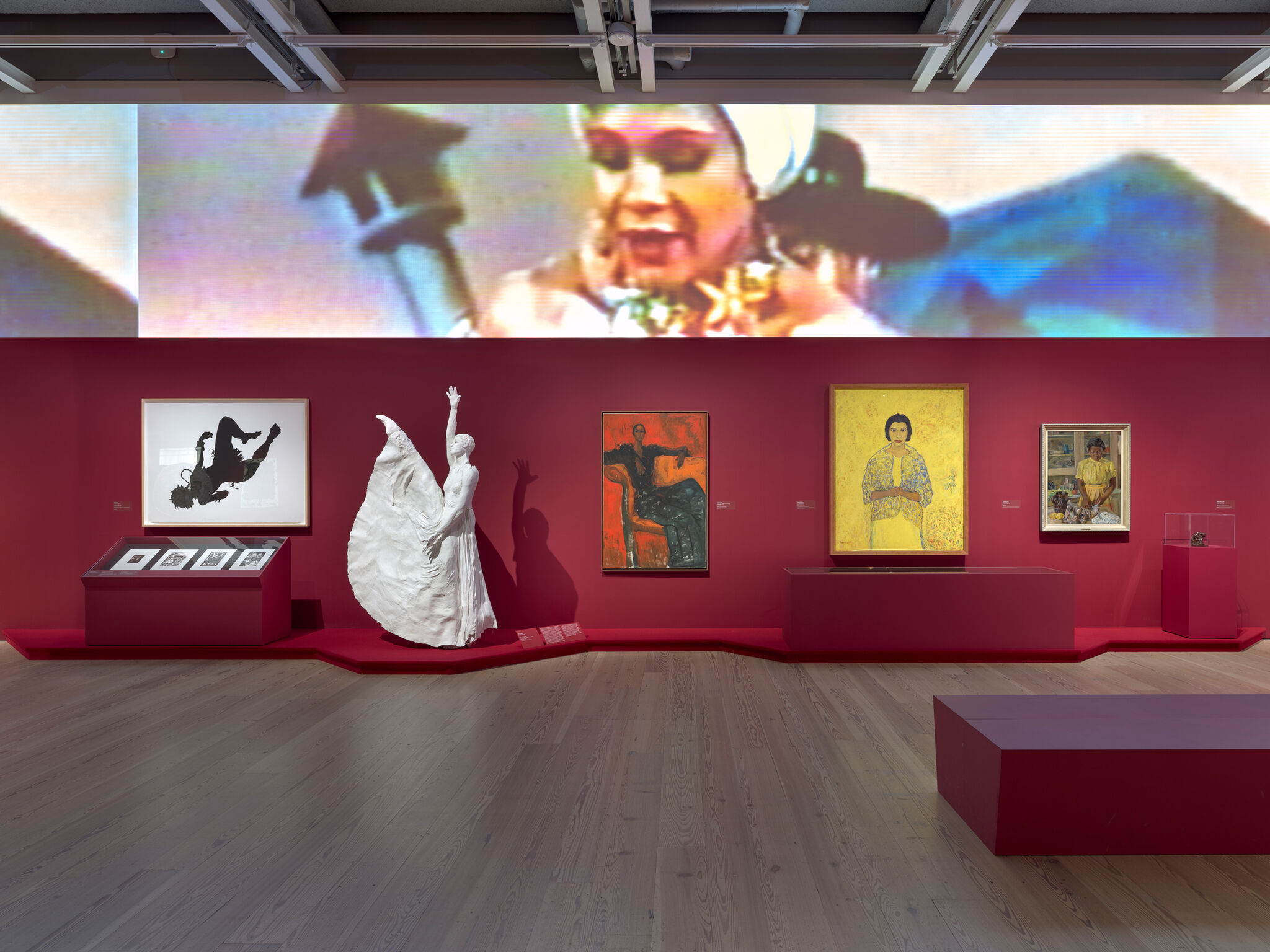

Installation view of Edges of Ailey (Whitney Museum of American Art, New York, September 25, 2024-February 9, 2025). In vitrine, from left to right: Elizabeth Catlett, I am the Negro Woman, 1947, printed 1989; Elizabeth Catlett, In Harriet Tubman I helped hundreds to freedom, 1946, printed 1989; Elizabeth Catlett, In Sojourner Truth I fought for the rights of women as well as Negroes, 1947, printed 1989; Elizabeth Catlett, In Phillis Wheatley I proved intellectual equality in the midst of slavery, 1946, printed 1989; From left to right: Kara Walker, African/American, 1998; Karon Davis, Dear Mama, 2024; Geoffrey Holder, Portrait of Carmen de Lavallade, 1976; Beauford Delaney, Marian Anderson, 1965; Loïs Mailou Jones, Jennie, 1943; Meta Vaux Warrick Fuller, Mother and Child (Secret Sorrow), c. 1914. Photograph by Ron Amstutz
From the exhibition Edges of Ailey
See also
-
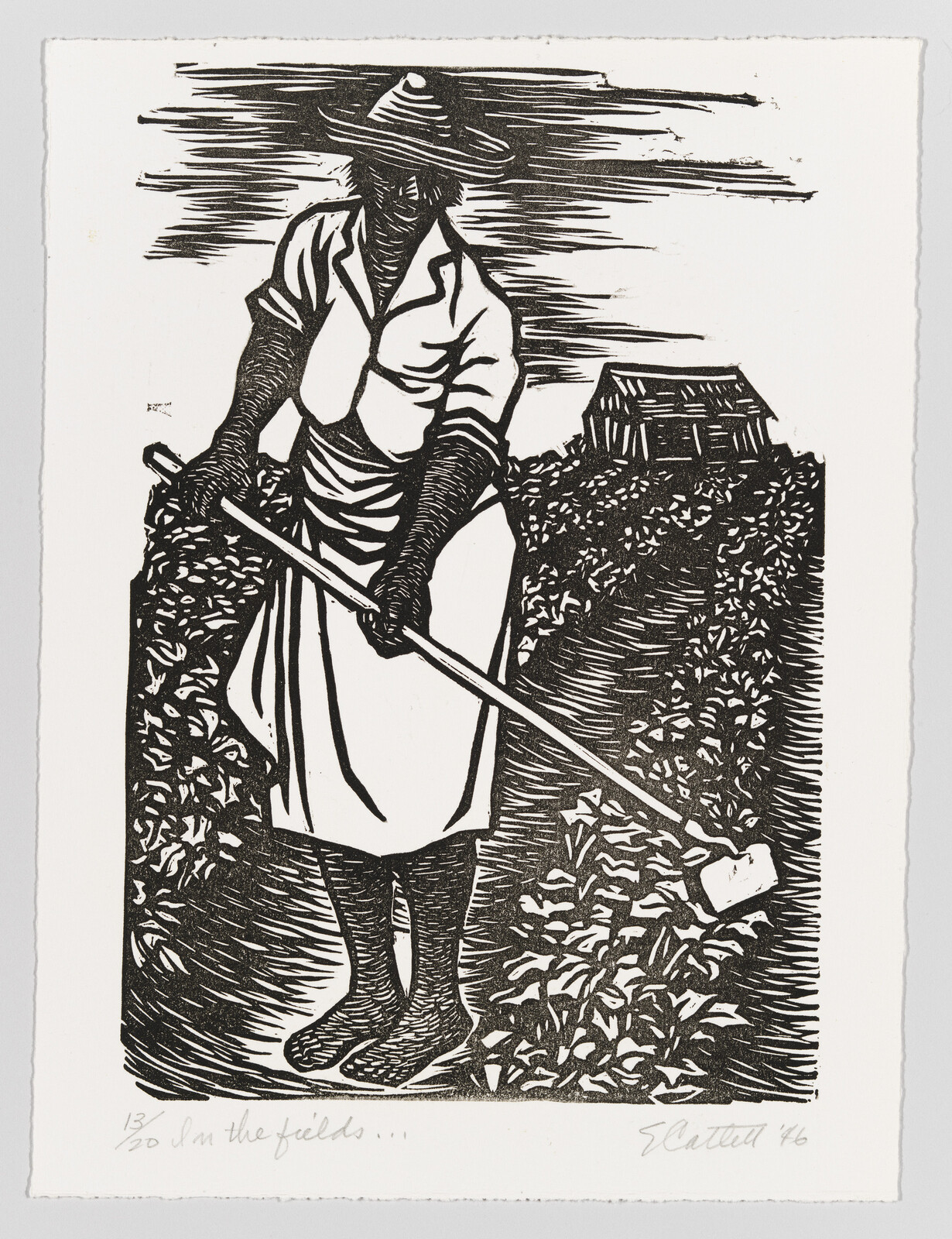
Elizabeth Catlett
In the fields...
1946, printed 1989 -
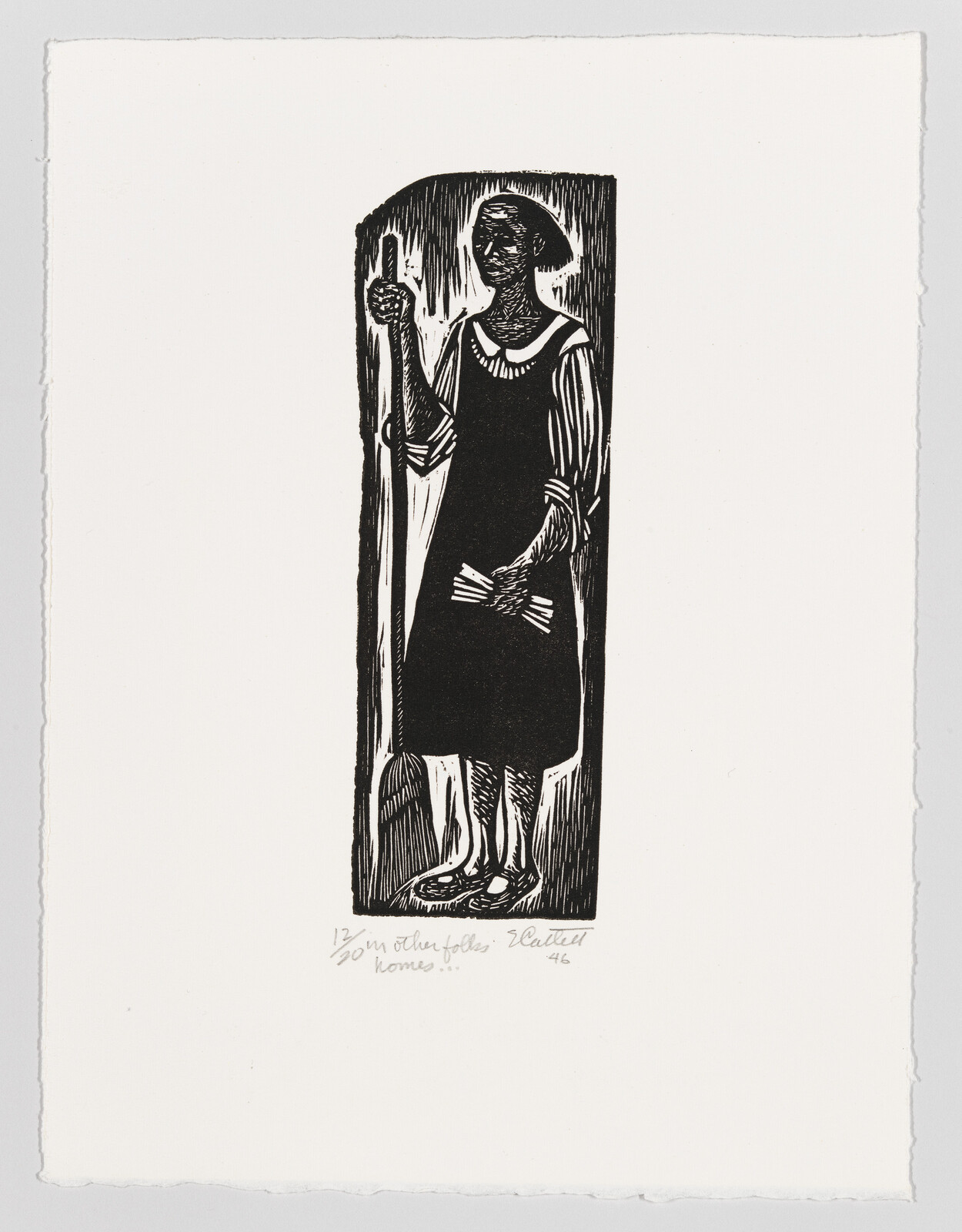
Elizabeth Catlett
In other folks' homes...
1946, printed 1989 -
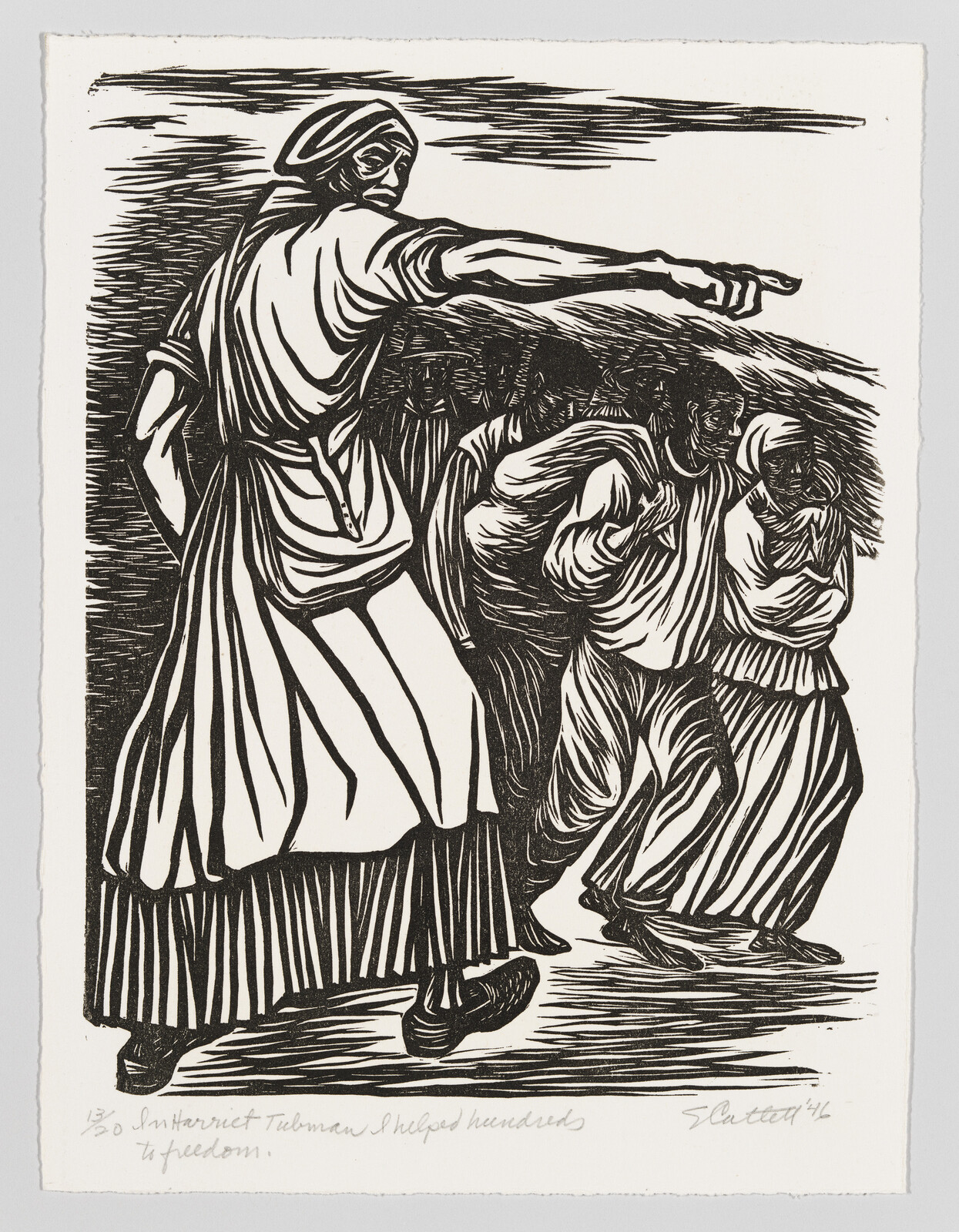
Elizabeth Catlett
In Harriet Tubman I helped hundreds to freedom
1946, printed 1989 -
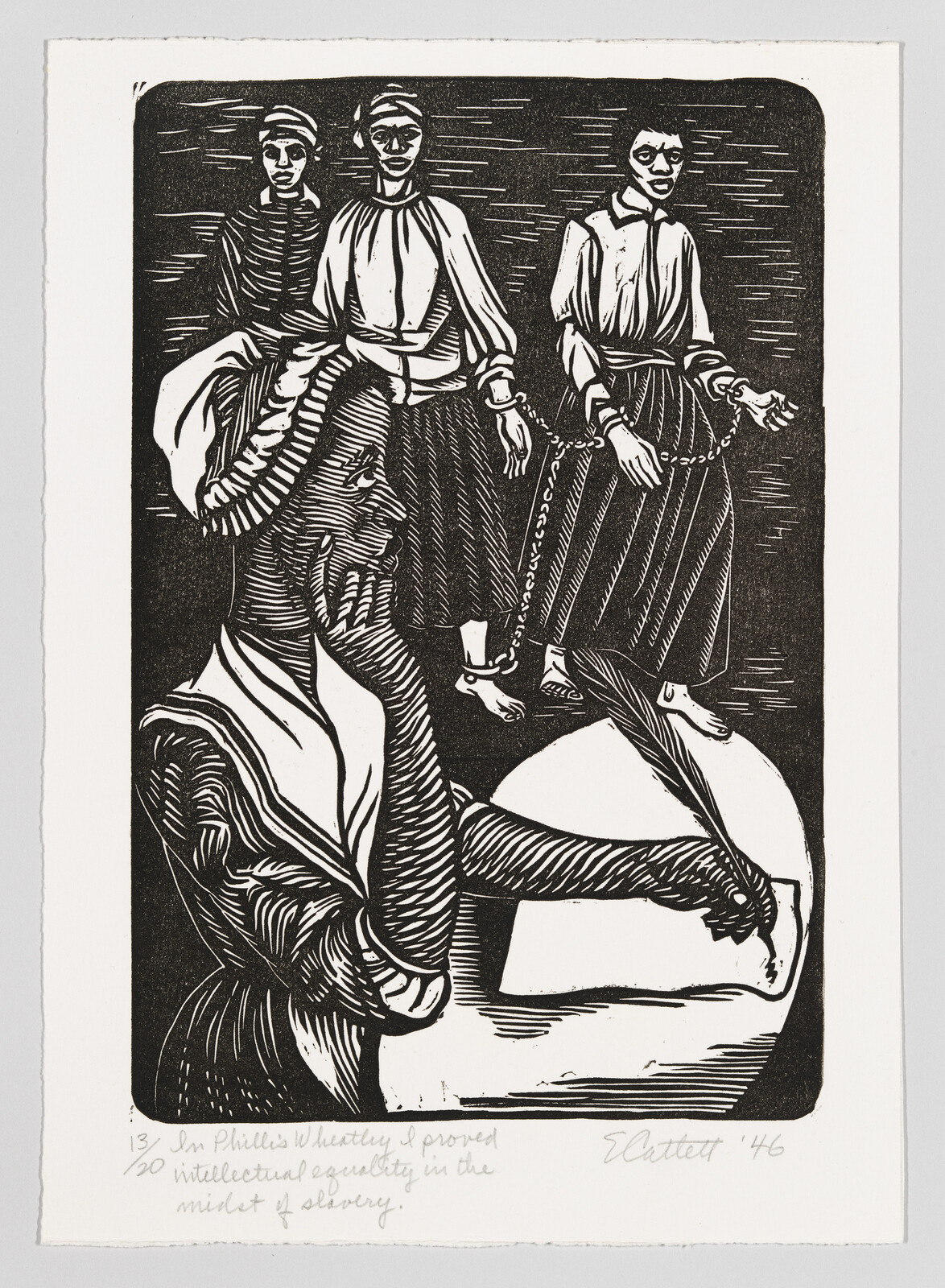
Elizabeth Catlett
In Phillis Wheatley I proved intellectual equality in the midst of slavery
1946, printed 1989 -
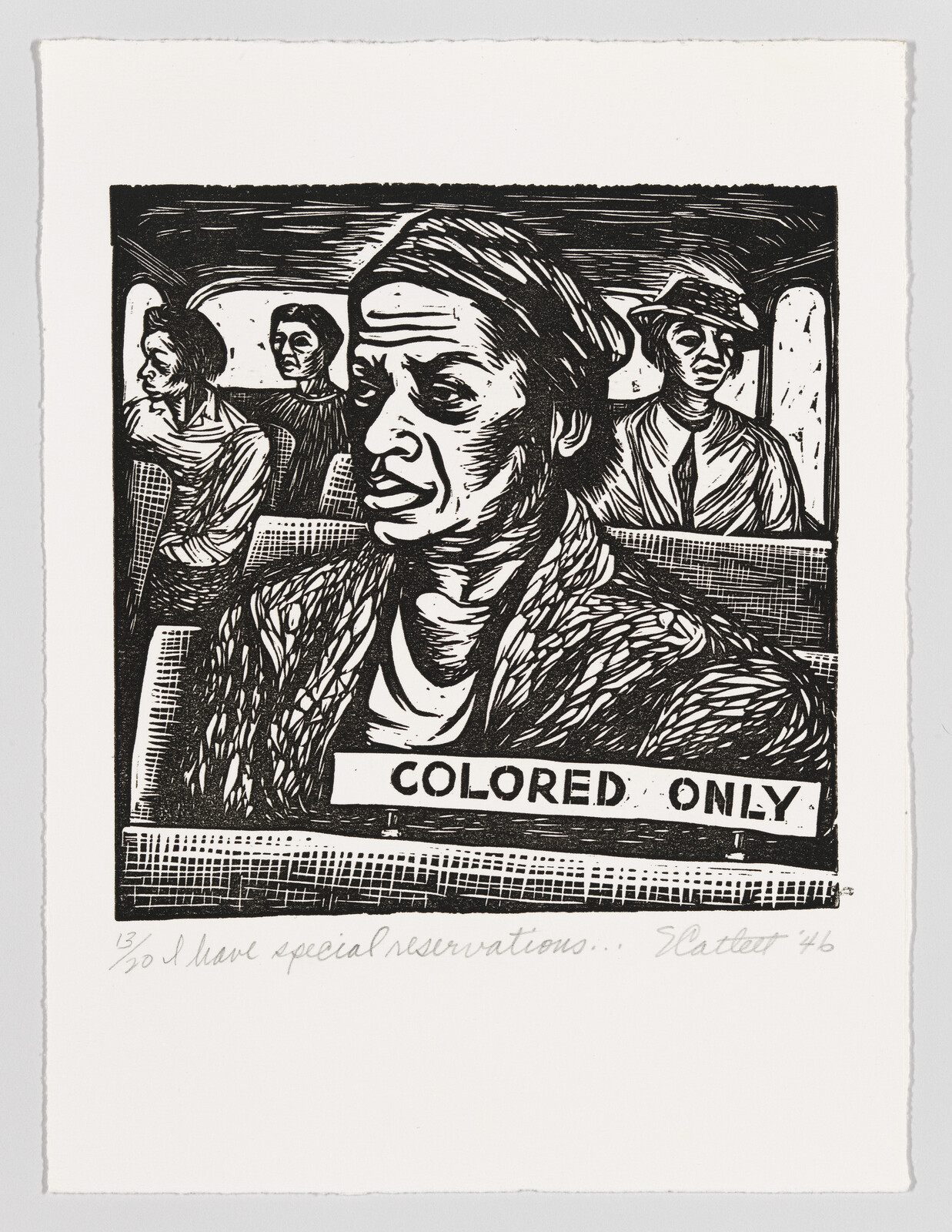
Elizabeth Catlett
I have special reservations...
1946, printed 1989 -
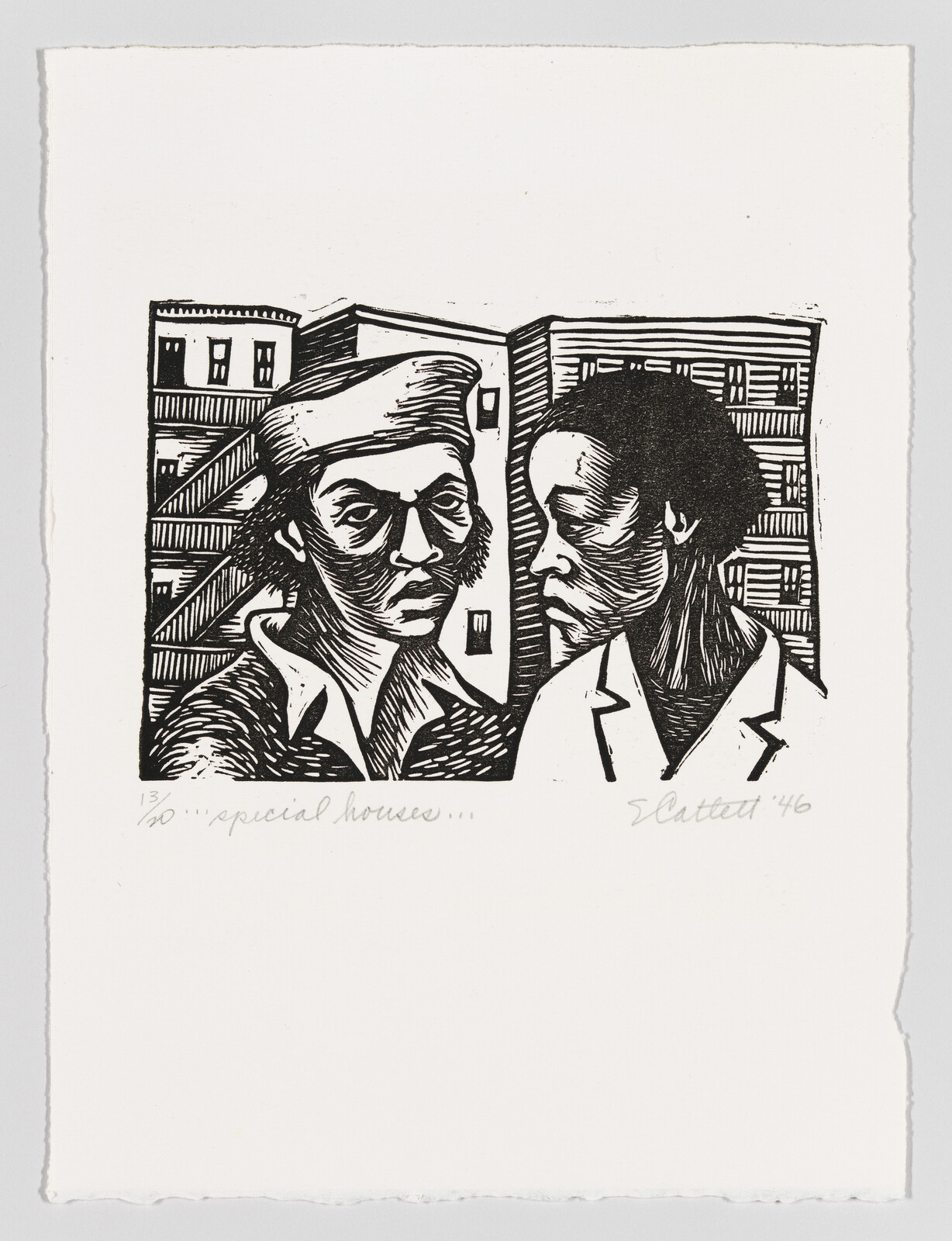
Elizabeth Catlett
...special houses...
1946, printed 1989 -
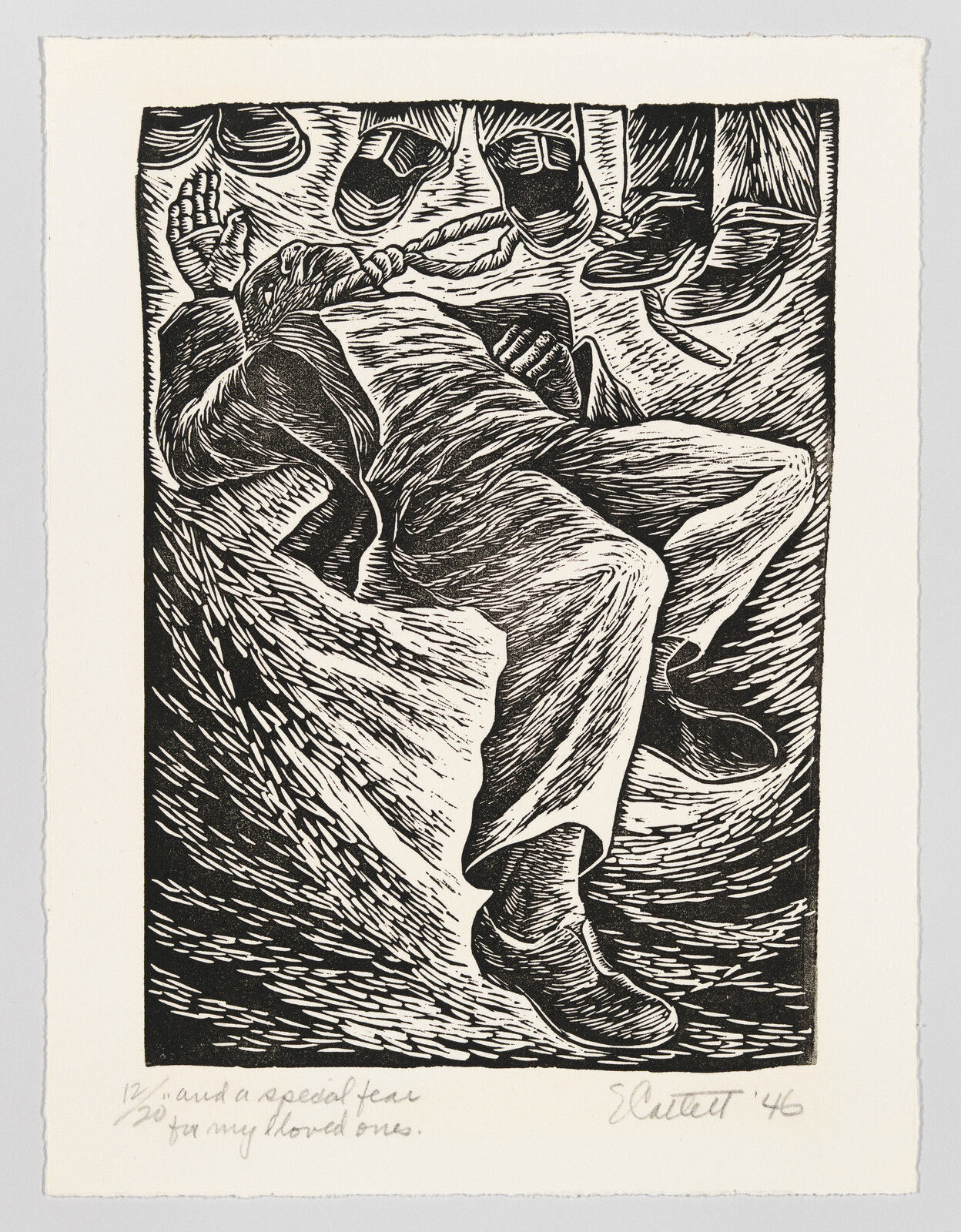
Elizabeth Catlett
..and a special fear for my loved ones
1946, printed 1989 -
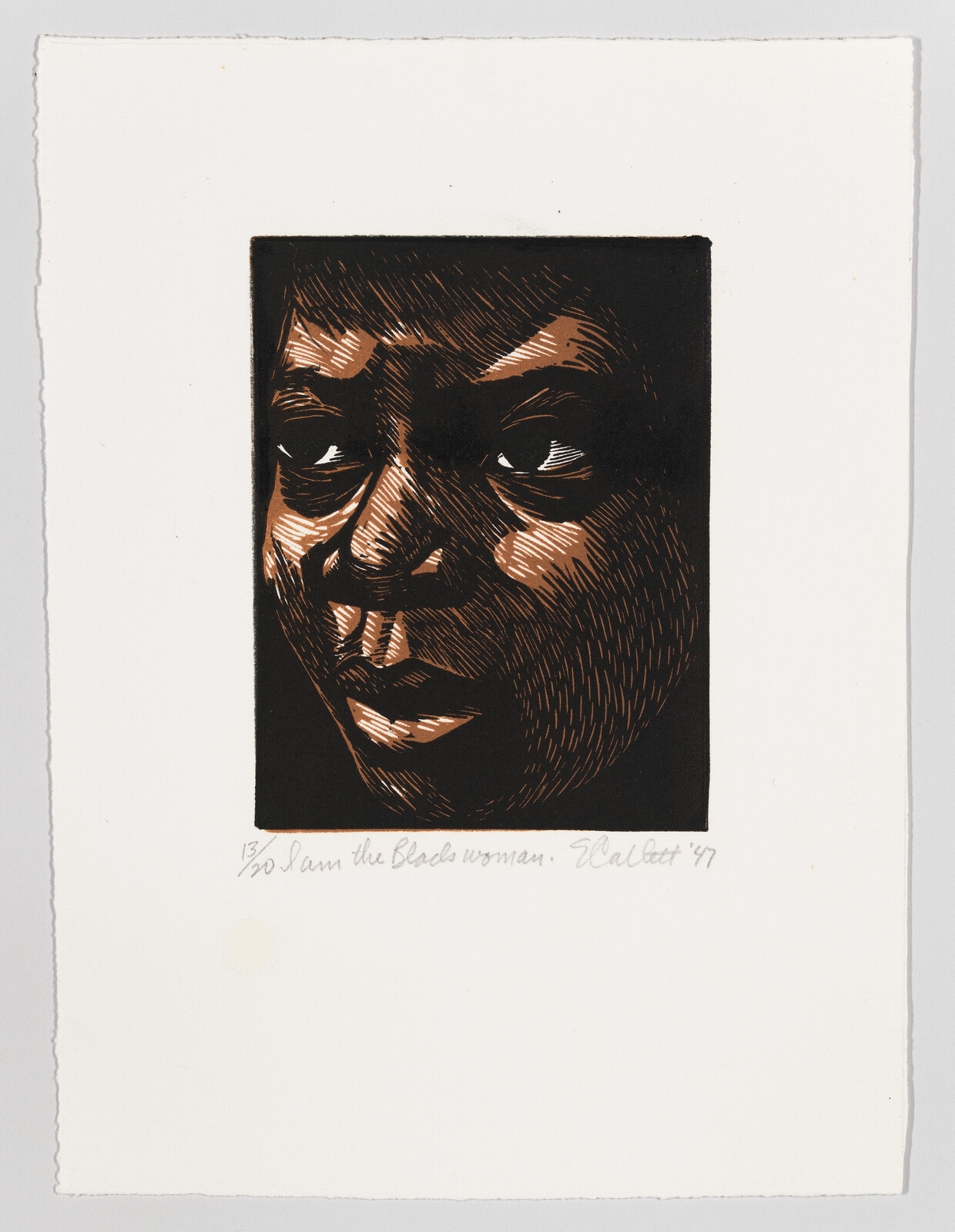
Elizabeth Catlett
I am the Negro woman
1947, printed 1989 -
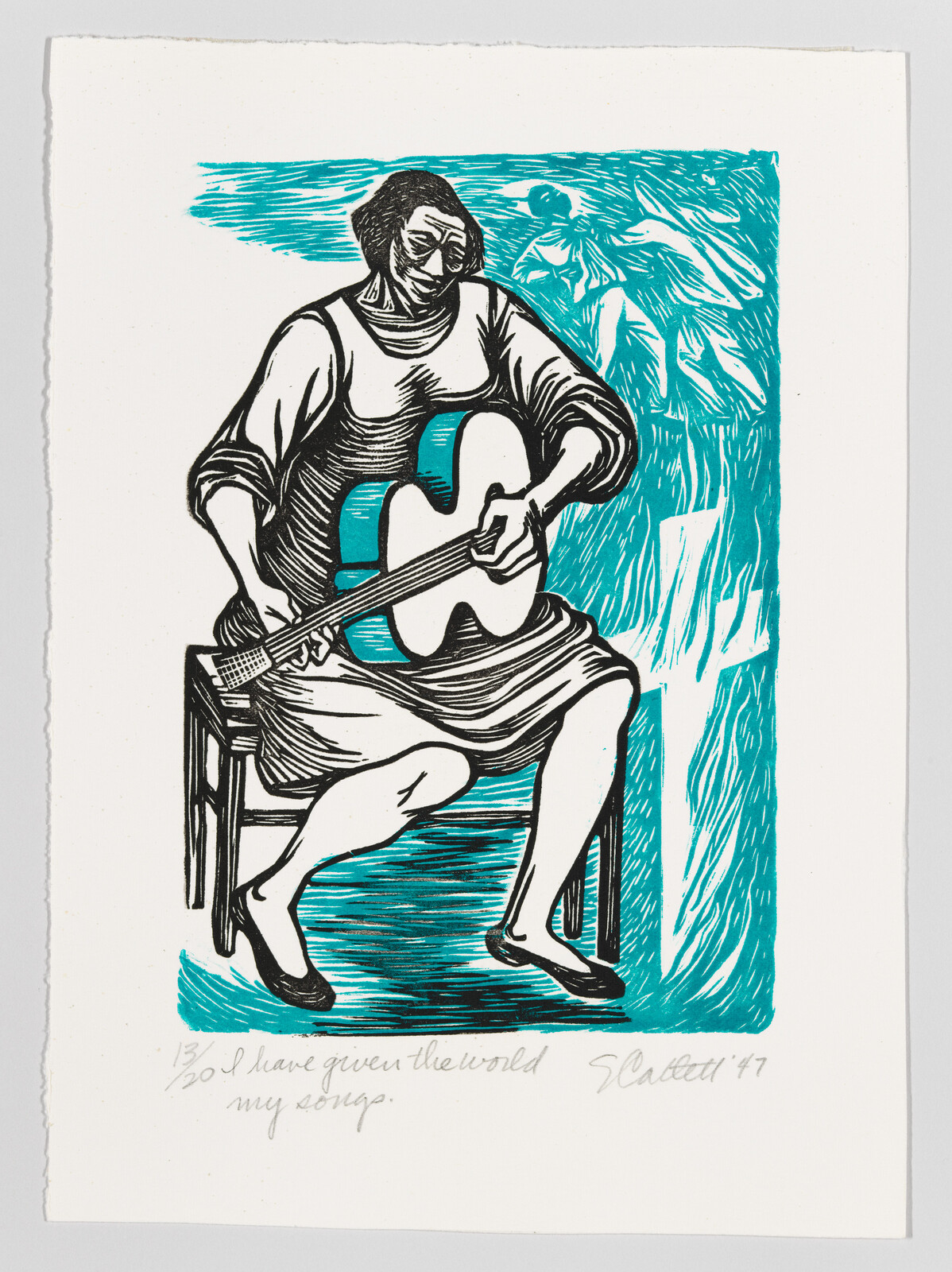
Elizabeth Catlett
I have given the world my songs
1947, printed 1989 -
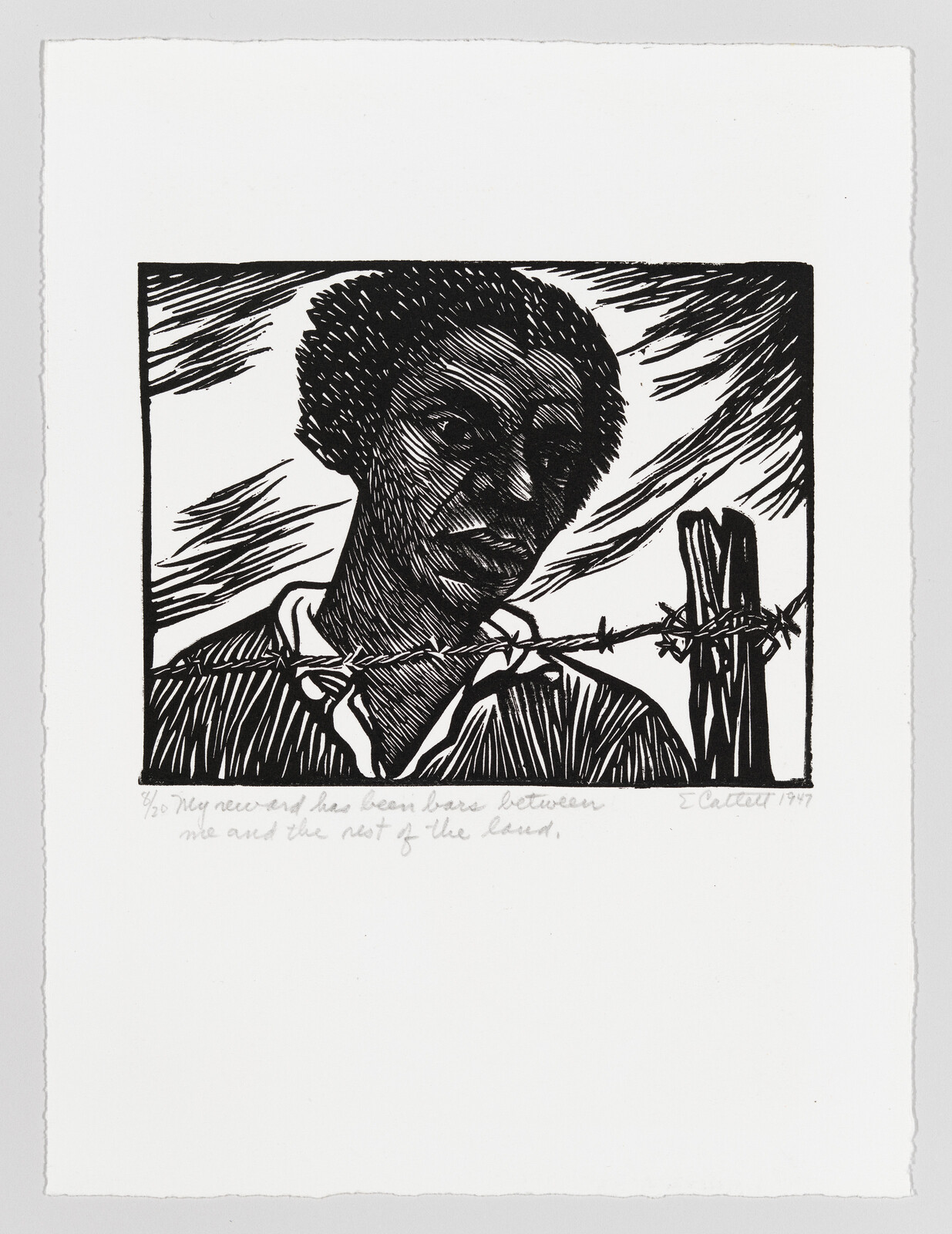
Elizabeth Catlett
My reward has been bars between me and the rest of the land
1947, printed 1989 -
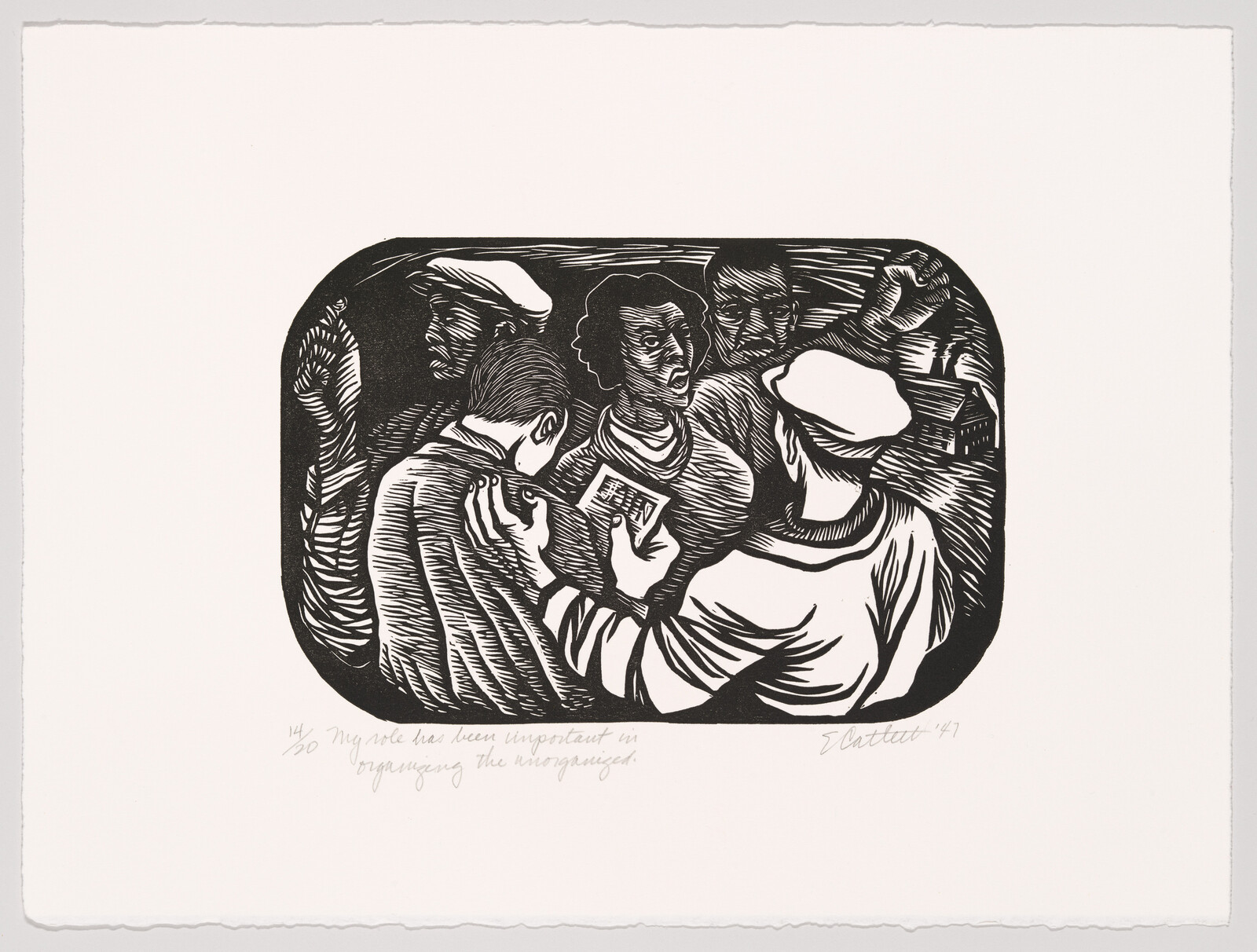
Elizabeth Catlett
My role has been important in organizing the unorganized
1947, printed 1989 -
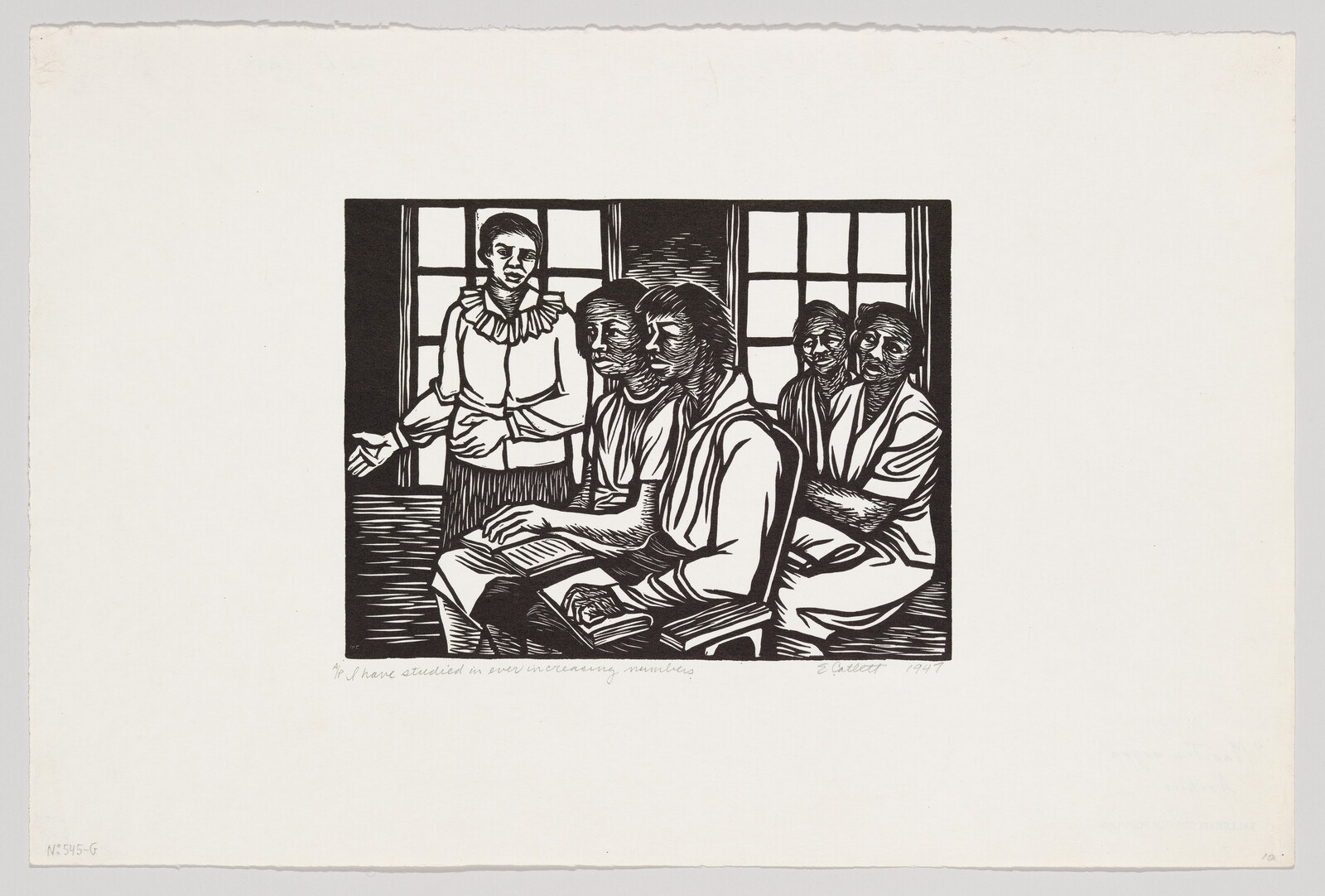
Elizabeth Catlett
I have studied in ever increasing numbers
1947 -
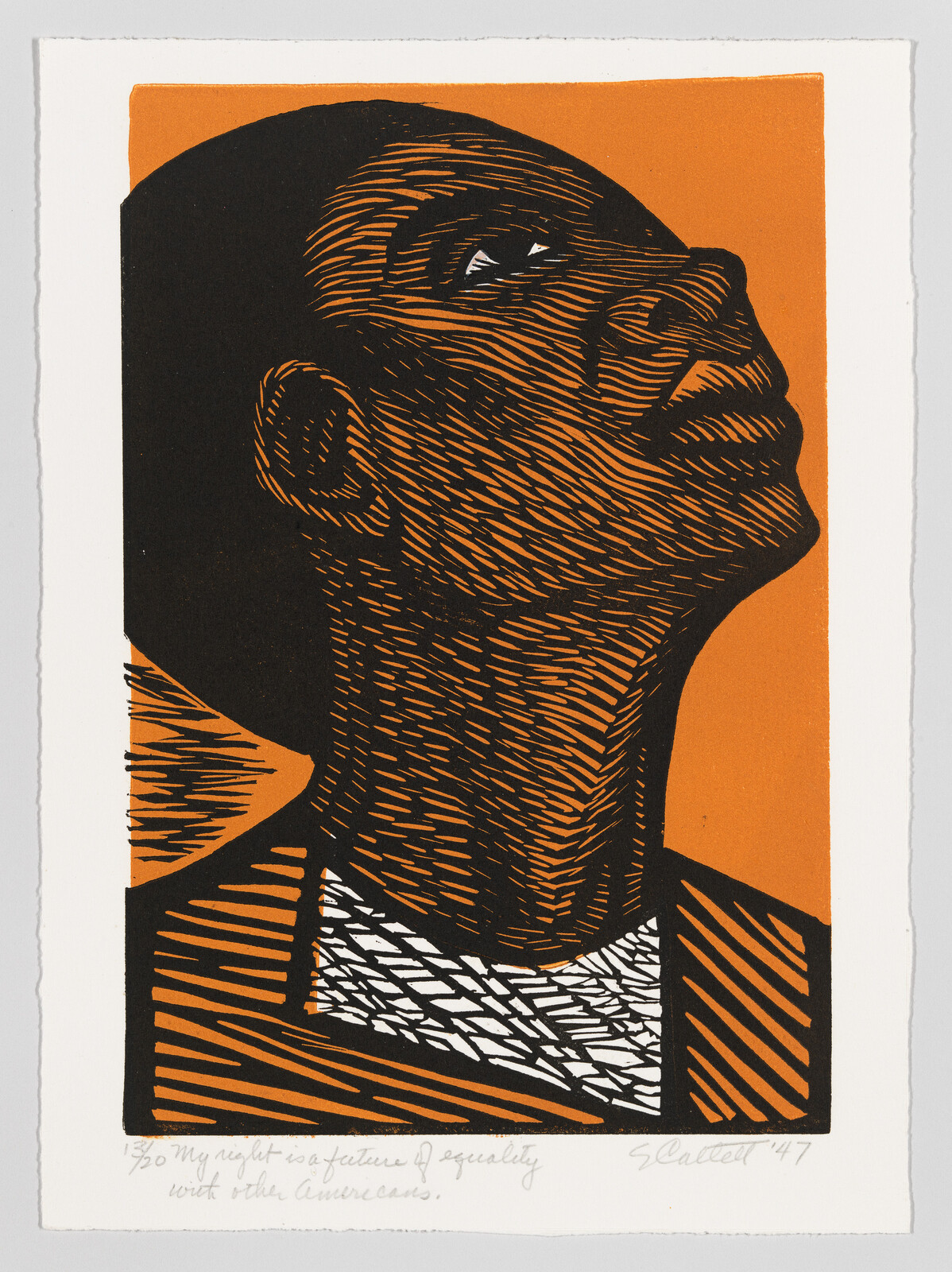
Elizabeth Catlett
My right is a future of equality with other Americans
1947, printed 1989 -
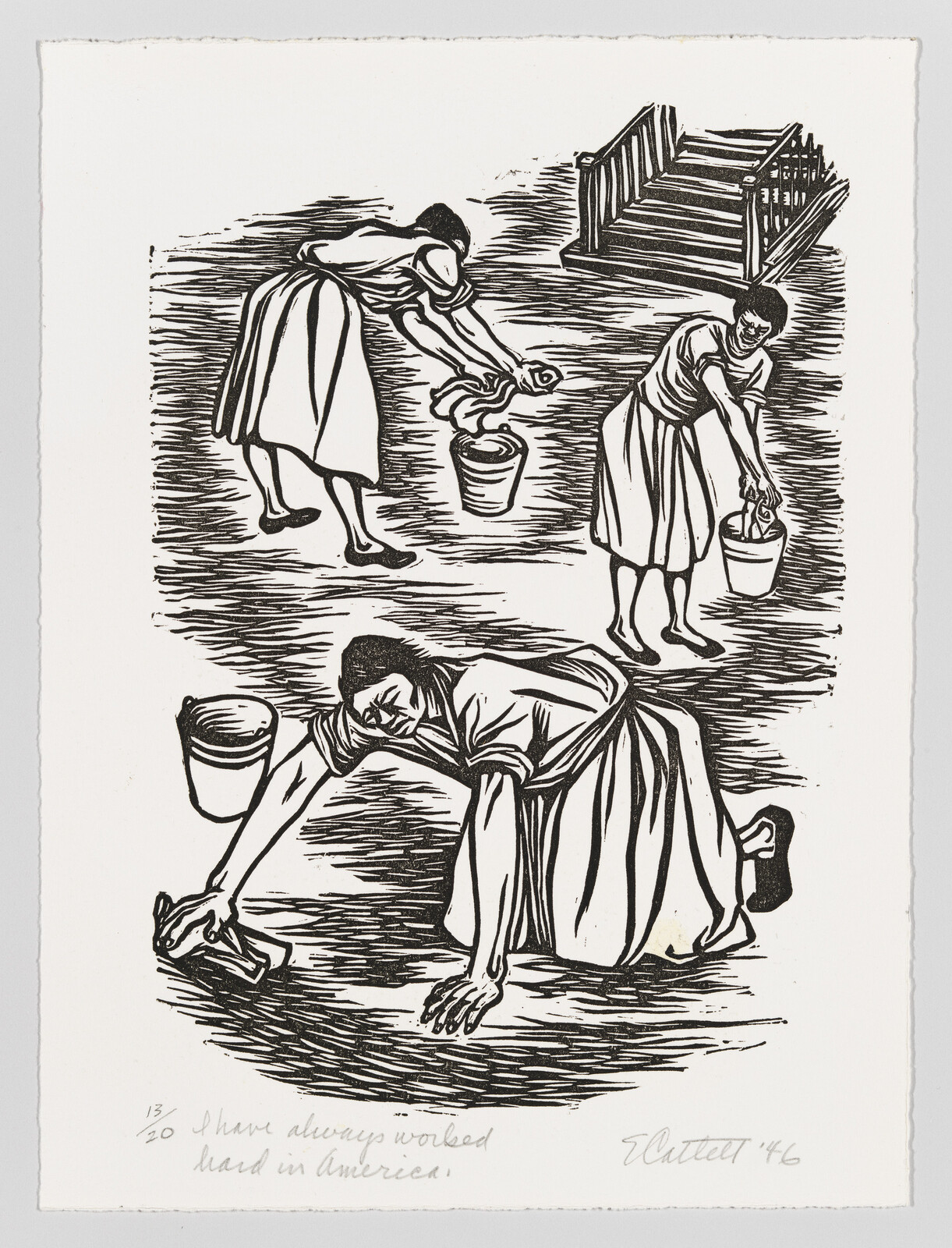
Elizabeth Catlett
I have always worked hard in America
1946, printed 1989

